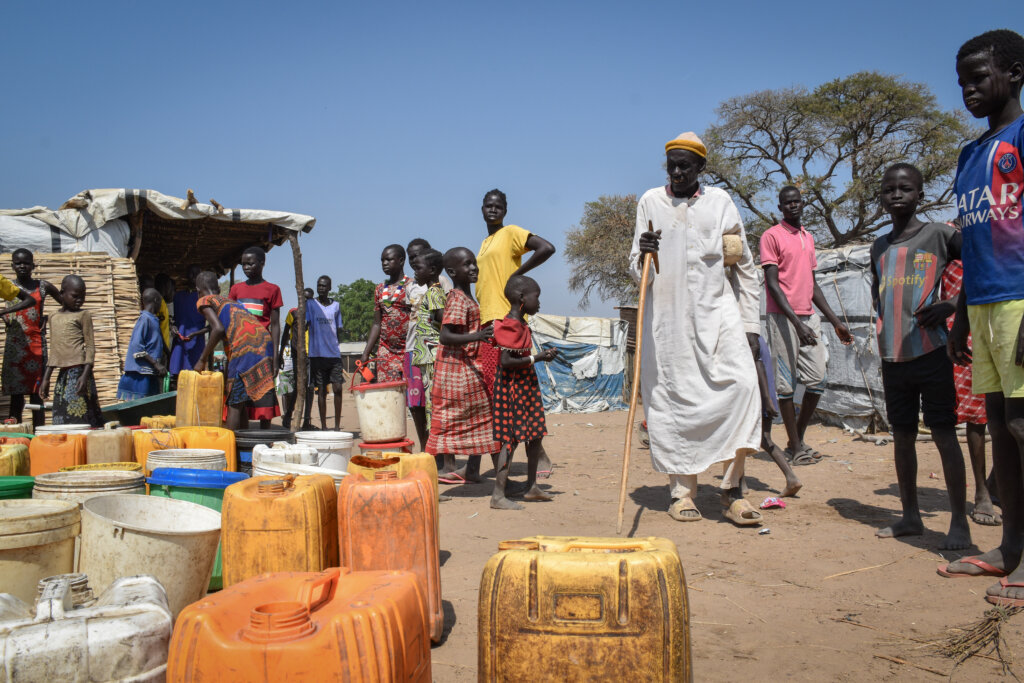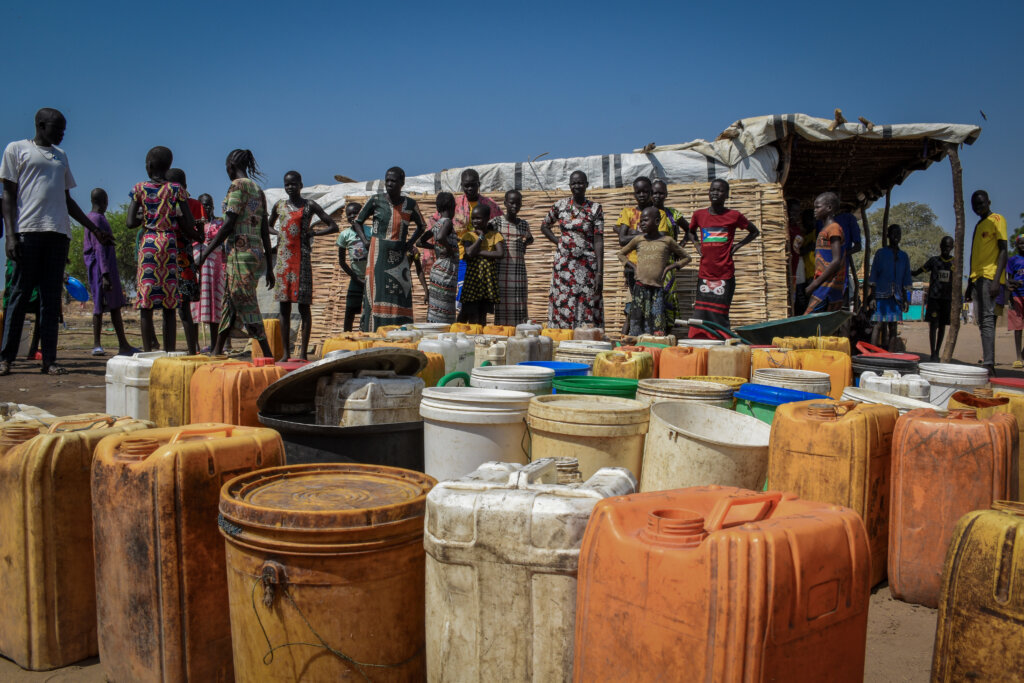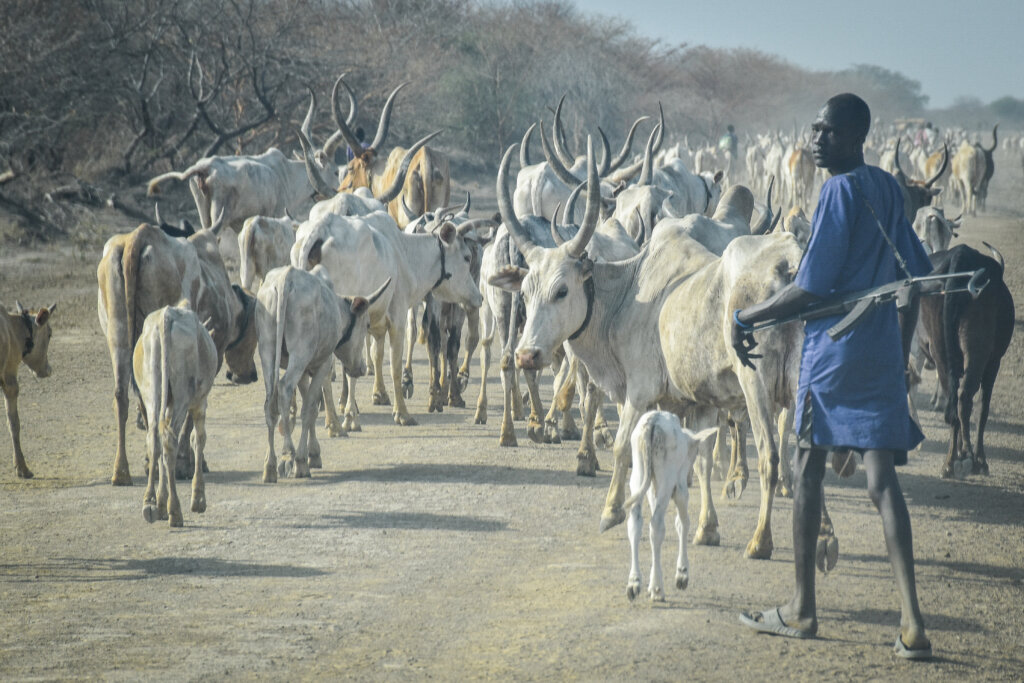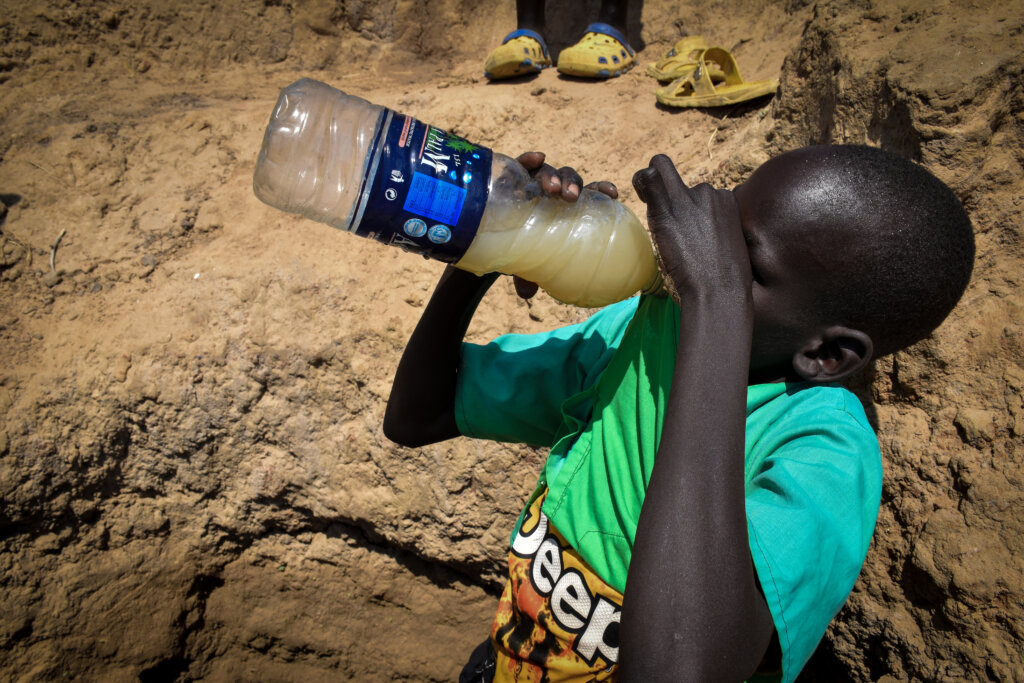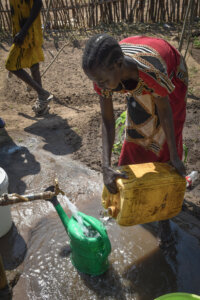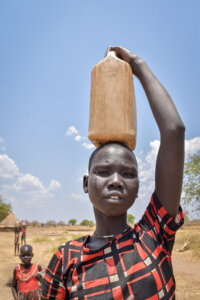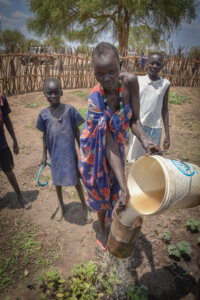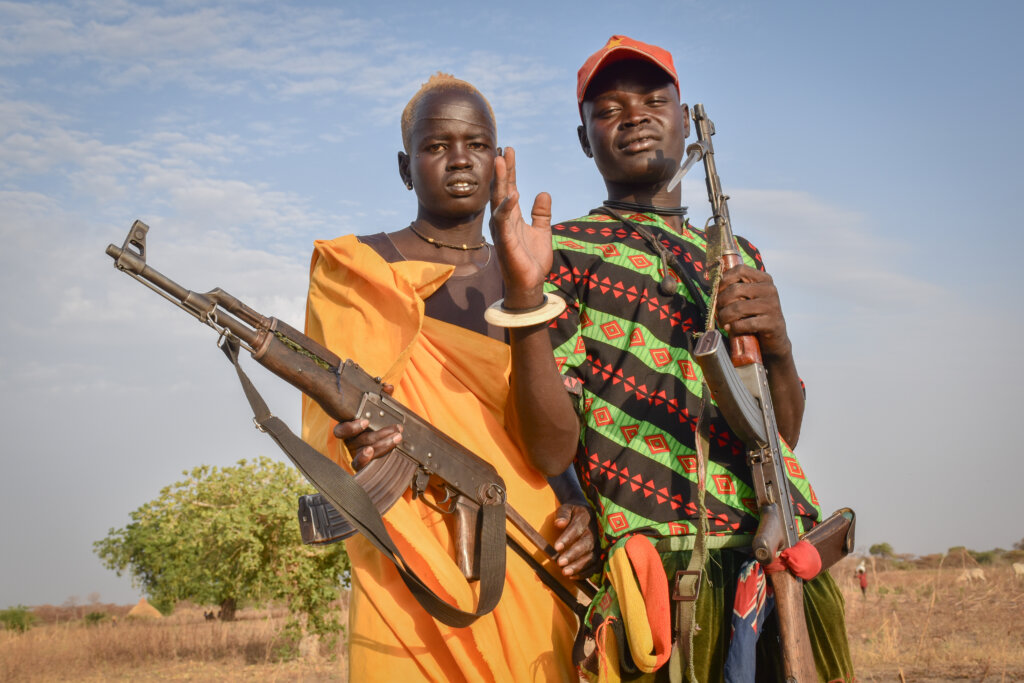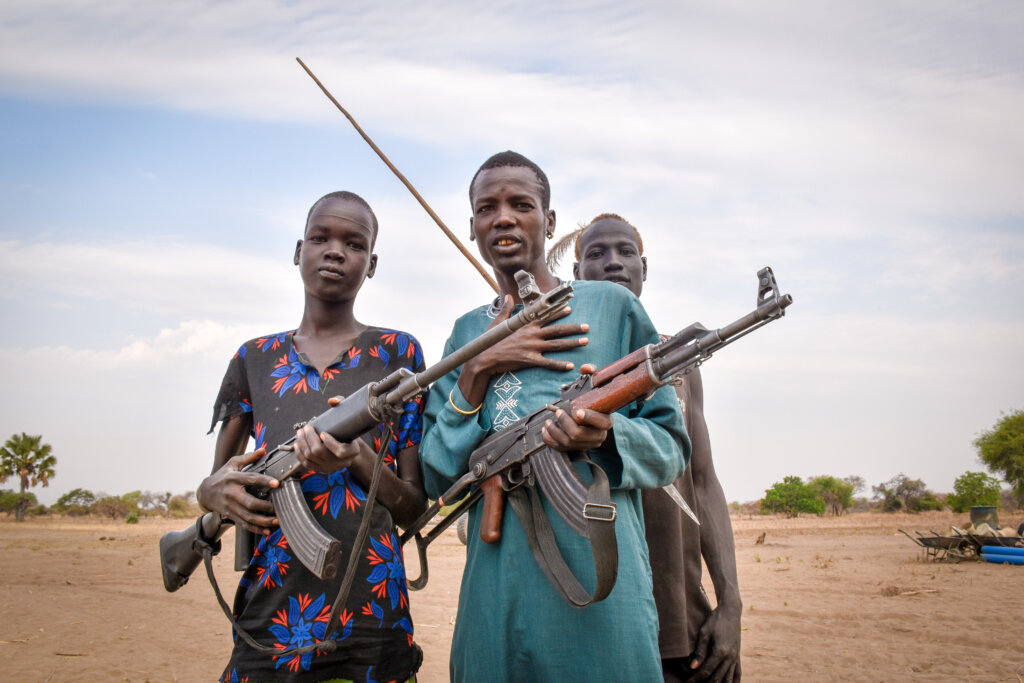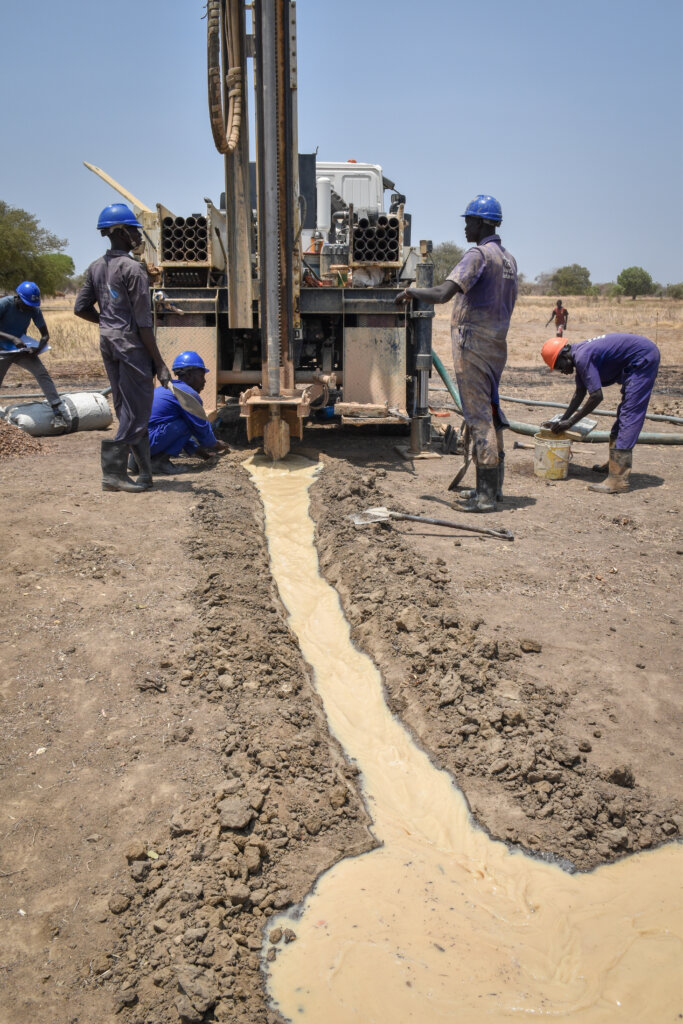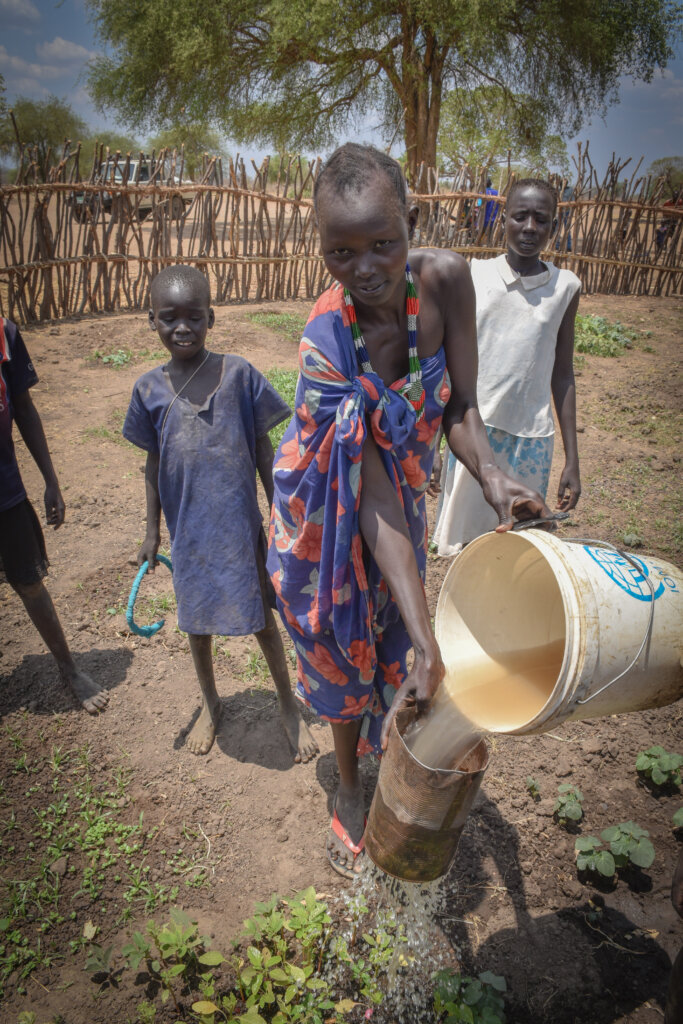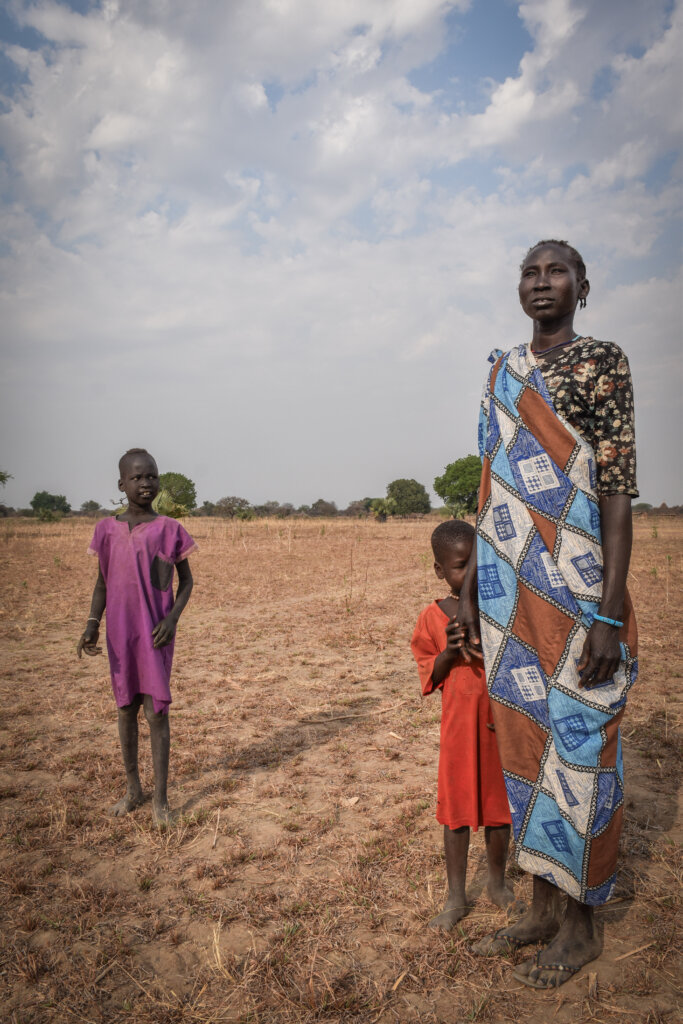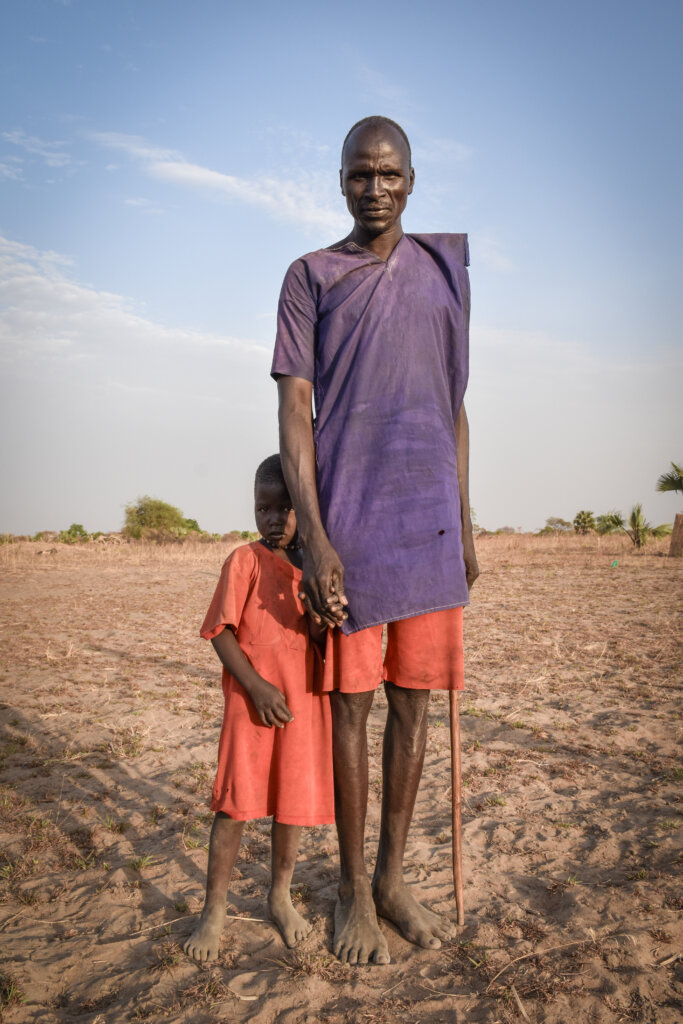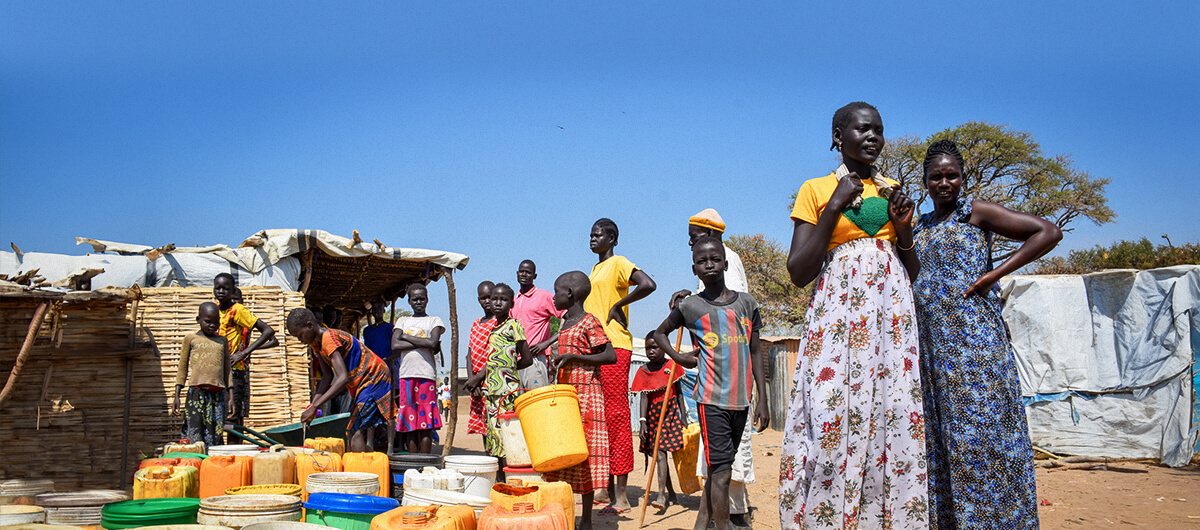

Photo: Ryan Biller
Climate Crisis
Photo: Ryan Biller
What the Western World Should Understand About South Sudan’s Water Crisis
The scorching hot temperatures and evaporating water levels in the war-torn African nation is a warning for our collective climate future.
This article was made possible because of the generous support of DAME members. We urgently need your help to keep publishing. Will you contribute just $5 a month to support our journalism?
Nyakuoth spent seven hours hiding in a muddy, hand-dug well after bullets started flying in South Sudan earlier this year. Cattle herders from a neighboring state, armed with AK-47s leftover from the civil war, had wandered into Nyakuoth’s community hoping to find water for their cows. But water was in short supply there, too; proprietorial locals opened fire, and the thirsty visitors returned the favor. In this war-torn African nation, where water has become scarce, climate change acts as a key ingredient in armed conflict.
“I was six months pregnant, so I got stuck (in the well). I was very scared,” Nyakuoth recalled. “Those boys were shooting at each other because it was too dry where they were. They needed a place for their cows. And everyone has guns here, so whenever anybody starts fighting over land or water, they start shooting.”
Roaming South Sudan are well-armed cattle herders searching for water and pasture. Meanwhile, the country grapples with long, bitter droughts and, in the rainy season, enormous floods. It’s an explosive combo; competition over dwindling natural resources between gun-wielding locals has tallied thousands of civilian corpses even after the civil war formally ended in 2020. Every year between 2013 and 2021 ranked among the globe’s ten hottest on record, and as one of the five countries most vulnerable to climate change, South Sudan is feeling the heat. Rising temperatures and falling water levels have killed livestock en masse, prompting cattle raiding and communal conflict. It’s also butchered local economies and inflated pre-existing humanitarian issues, especially those involving women.
So far this year, hundreds have already been killed in these sorts of clashes. At least 38 people were murdered in early February when herders wandered into a different state searching for water and pasture. Another 150 were slain a few days later in the east. It’s an ongoing problem here in the world’s youngest nation, one that showcases the concentric circles of peace, war and climate. “There is no other peacekeeping mission where the connection between climate shocks and conflict is as clear as it is in South Sudan,” said Nicholas Haysom, head of the United Nations Mission in South Sudan (UNMISS).
So even though South Sudan isn’t tangled up in an official war, peace remains dangerously fragile. And it is water—or the lack thereof—that is ominously sowing the seeds of future conflict here in Africa.
“I am not a fortune teller,” Nyakuoth said, “but I do know that bullets will keep flying as this land gets drier.”
***
Most Americans don’t get it. Or at least, that’s what Achol Anoka, a South Sudanese primary-school teacher, believes. “Our water is disappearing. And it is one of the reasons why young men murder each other,” she said. “You Americans and your environmentalism in Africa. It’s about the elephants and the lions. But what about the people? What about us?” Anoka then added, rather ominously, that most Americans have no clue about the looming catastrophe that is global warming. “Most developed countries don’t,” she said. “Not yet.”
However, man-made climate change is shrinking the West’s water supply, too. The difference then is that, for a country like South Sudan, one of the poorest in the world by GDP, there isn’t enough infrastructure in place to cushion the blow. Citizens of wealthier countries, like former U.S. president Donald Trump, have been able to shrug off man-made climate change—either as a globalist conspiracy theory or simply left-wing fear mongering—for this exact reason. But for those living on the frontlines of the climate crisis, there’s no room for doubt.
During the interview, Anoka paused, wiped sweat from her brow, then guzzled a plastic bottle of water. It was March 16 when she spoke to DAME, a day when the capital Juba was being cooked by a 106 degree high (two days later, an even worse heatwave fell over the country, causing school closures, which canceled Anoka’s classes, and power cuts). “So, you tell me some Americans don’t believe man-made climate change is happening. (In South Sudan) we don’t get that luxury.” Anoka then pointed out the dark irony; despite being one of the most affected by global warming, the entire African continent contributes only 4 percent of the world’s total carbon emissions, whereas China, India, the United States and the European Union together spew out over 80 percent.
And the American government has done little to change course; Trump called climate change “an expensive hoax” and bailed on the Paris Agreement while President Joe Biden—despite acknowledging it as a “threat multiplier,” which echoes thinking within the defense sector—ramped up oil production (under Biden, U.S. oil production was higher than any country in history by the end of 2023).
To be fair, changing course is easier said than done. Like several other African nations, South Sudan is a sizable oil producer whose economy depends on oil exports. The International Monetary Fund says 90 percent of South Sudan’s official revenue base is derived from petroleum exports, and that’s by a conservative estimate.
A global effort—largely led by wealthy Western countries—to shift away from global petroleum to limit climate change’s impact is a double-edged sword, says Dr. Matthew S. Benson, Sudans Research Director for the London School of Economics and Political Science. On the one hand, it is “desperately needed” and “long overdue.” But the ripple effect that decarbonization might have on conflict-affected African countries like South Sudan remains understudied, he said.
Experts argue that global decarbonization should account for African countries, like South Sudan, and their reliance on oil revenue. People like Anoka welcome the idea of alternative energy, saying the South Sudanese people have barely seen a penny from the oil beneath their feet thanks to corrupt, extortionate political leadership.
“This place is cursed by oil,” Anoka said. “We have plenty of it, but it’s sold to other countries to burn. We get poorer, other countries get richer, and Africa keeps getting hotter.”
***
In February 2020, when South Sudan’s brutal civil war officially ended and just before the World Health Organization declared the onset of a global pandemic, something else was happening worldwide: Temperatures were shattering record highs. It was overshadowed by the pandemic, but 2020 tied 2016 as the hottest year in nearly a century and a half, according to the Annual 2020 Global Climate Report.
When 2020 ended, UNMISS Human Rights Division had documented 2,421 civilian killings, more than double that of 2019, back when an active war was still being fought. Although this time people weren’t being killed by government forces or the rebels, but instead community-based militias concentrated to just 13 percent of the nation’s 540 payams, or administrative areas. And it just so happened that these regions were some of the worst affected by drought. To contain the chaos, UNMISS deployed peacekeepers to these parched pockets of South Sudan, and it did so ahead of the dry season, specifically citing contention over scarce resources as the basis for the violence.
And the rainy season brought little relief. Floods submerged vast swaths of the country in 2021, contributing to the more than 300,000 who’ve been displaced by flooding in a three-year period (these floods also squeezed South Sudan’s already ramshackle health sector, as typhoid, malaria and ringworm cases skyrocketed). When 2022 came around, South Sudan had been ranked the world’s most vulnerable country to climate change, as well as the least capable of coping with it. And all the while, the young nation remained plagued with brutality.
Some activists, like Edmund Yakani, suspect political motivations behind the clashes, alleging that certain politicians may be fueling the violence to influence the upcoming presidential election this December—the first in the country’s history. Ethnic tension, especially between the Dinka and Nuer groups, also remains inflamed, which lubricates conditions for violence.
So water is only partly to blame. The federal government remains at an impasse, and its anticipated presidential election will likely get postponed. A census hasn’t been conducted, a constitution hasn’t been ratified, and the National Elections Commission hasn’t received funding. Progress in creating a unified national army has been slow, too. Without these boxes checked, an election won’t happen. (Not to mention that, at the moment, there is no other candidate on the ballot).
For a country as politically, socially and economically messy as South Sudan, climate has made the region’s ongoing problems especially combustible. Water insecurity, for example, is an indirect but no less potent factor.
“Given this fraught political environment, concerns about flooding and drought are serious but more manageable if there were the political will,” says Dr. Joseph Siegle, Director of Research at the Africa Center for Strategic Studies. “The more unpredictable weather South Sudan has been experiencing in recent years has added further shocks to an already fragile system.”
***
South Sudanese President Salva Kiir iconically sports a black cowboy hat—a gift from then-U.S. President George W. Bush in 2006. Nearly two decades later, after achieving sovereignty and weathering a bloody civil war, the hat remains on Kiir’s head. It’s a metaphor of sorts for the U.S. support Kiir and his government have enjoyed through the years.
Bush’s administration helped facilitate South Sudan’s secession from its northern neighbor, Sudan, in 2011. Post-independence, the Obama administration was active in the formation of an official South Sudanese military by funneling in $40 to $60 million each year. Toward the end of Obama’s tenure the East African country, now awash with weapons, was at war. And it seemed to grow bloodier by the day. So in the waning days of the Obama administration, the U.S. sought a U.N. Security Council mandate for an arms embargo on South Sudan. Russia and China opposed it, and the attempt fizzled out.
By the time Donald Trump took the White House in 2017, South Sudan was unraveling. War had been raging for three years. An estimated 50,000 were dead, over a quarter of the population uprooted. At first, Trump overlooked the situation. It was only after Ambassador Nikki Haley’s visit to South Sudan that the administration decided to impose its own arms embargo on the country, encouraging the U.N. and others to follow suit. The U.S. had invested more than $11 billion in South Sudan, but Haley had told Kiir the Americans were “questioning that investment,” as well as warning Kiir the U.S. had lost trust in his government. She even described the paunchy bushfighter-turned-president as an “unfit partner” in the pursuit of peace.
Despite Trump’s arms embargo on all parties involved in the war (a mostly symbolic act since the U.S. had no arms trade with South Sudan), weapons kept pouring into the war-scarred nation. A Conflict Armament Research report spotlighted evidence that Uganda was South Sudan’s biggest weapons conduit. A close ally of Kiir during the war, Uganda was “the main transit point and facilitator for arms and ammunition,” according to former U.S. diplomat Payton Knopf.
So by the time Kiir and opposition leader Riek Machar (now South Sudan’s vice president) put aside their differences and settled on a peace agreement, unaccounted for arms were scattered across South Sudan. Weapons made in China, Israel, the U.A.E. and Ukraine, supplied to the two main parties in the war from neighboring countries like Uganda, were in civilian hands. (A report found 99 percent of the ammunition and 37 percent of the weapons in South Sudan since 2014 to have been manufactured in China.)
A small arms assessment from the UNDP discovered the most common household firearm to be “automatic weapons,” namely the AK-47. Today, in villages and markets outside Juba, almost anybody can get one of these Soviet assault rifles for the low price of just one cow (for reference, the unofficial exchange rate of a cow is about $500, and considered relatively cheap). These wartime weapons are the ones that now render disputes over land and water deadly, converting arguments into massacres.
***
In South Sudan’s Warrap state, under the shade of a sausage tree, Salva Dut was conversing with his team when a pair of teenage boys wandered through camp. To Salva and his colleagues, the dusty AK-47s slung over the boys’ shoulders were no more conspicuous than their sandals or T-shirts. Salva, founder of the non-profit Water for South Sudan (WFSS), nodded to the armed teens. “See,” he said, “these things are everywhere.”
Dut, a former “Lost Boy,” came to Rochester, New York, from an Ethiopian refugee camp. Years later he returned home, where he reunited with his father, alive, but suffering from a waterborne illness. “I knew then I had to do something about water,” he says. He drilled a well in his dad’s village, and Water for South Sudan was born. Since 2005, the group has drilled over 600 wells across the country. In the organization’s early days, Dut had to worry about road landmines and resource constraints. “Now it is climate change,” he said. “Climate change worries me more than anything else.”
He watched as storm clouds swelled overhead in the town of Wau. It was March, still too early for the rains to come. And yet it had rained just a few weeks ago. “In all my life I haven’t seen rain come so soon,” he said. The abnormal precipitation patterns have thrown a wrench in his work, as WFSS can only drill in the dry season, when the roads are still intact. But now, because of shifting climate patterns, the rains are more sporadic than ever.
This is partly explained by El Niño and La Niña, otherwise normal climate patterns in the Pacific Ocean with weather implications worldwide, which scientists believe are being intensified by global warming. For Equatorial East Africa, this makes for a wetter, shorter—but more ferocious—rainy season, the very kind that has unleashed havoc-wreaking floods on South Sudan in recent years. It also means much drier dry seasons, according to the National Ocean Service, exemplified in South Sudan by the widespread desertification it’s suffered.
Still, WFSS has kept its foot on the gas. The work is too important, and the rains will come regardless, and with a vengeance, in April. So there’s no time to waste, even amid an increasingly uncertain precipitation schedule and in lieu of a series of extreme heat warnings issued by local meteorologists. Temperatures this March exceeded 114 degrees in parts of the country, for example, and have broken triple digits every day of the month (Sarah Oliver, a South Sudanese business student, told DAME she was “going to melt” amid the latest heatwave).
On a 108-degree March afternoon, a group of boys hung out by a rudimentary, hand-dug well. With old plastic Pepsi bottles they scooped and sipped water – cloudy, brownish, and full of dirt. One boy, who stood knee-deep in the well, innovatively pulled his shirt over his face and drank through the fabric, a makeshift filter to keep from swallowing the rocks and dirt. Salva stood at the scene. “Too many people here have to deal with not enough, too much, or dirty water. We’re trying to change that,” he said, thumbing sweat from his eyes. “But this,” he referred to the heat, “is a concern.”
“Despite the heat, despite the danger, this work is more important than ever,” said Ajang Abraham Agok, Country Director for WFSS. “Clean drinking water prevents disease, but it also can prevent fighting. In many parts of the country, five or six villages share one well. During a drought, people argue and fight over access to the well. But if each community has their own, it reduces conflict over water.”
***
The human implications of a changing climate are stark when bodies start piling up over natural resources. Less apparent is the burden it imposes on day-to-day life, especially those of women. “Women and young girls suffer a lot here,” Dut said. “Maybe the most.” UN Special Rapporteur on Violence against Women and Girls Reem Alsalem echoed this sentiment in an official report arguing that climate change is a threat multiplier for women and girls worldwide.
Most South Sudanese women are tasked with fetching water (a chore that usually includes a multi-hour walk, several times a day). Amid the country’s recent soaring temperatures, these women don’t have the luxury of retreating into an air-conditioned building where clean drinking water can be summoned with the turn of a nozzle. If they want water, they must walk to it under the same blistering heat that shuttered schools and killed power in March. The sight of women and their daughters marching through the bush, with calloused feet and sweaty brows, balancing empty jugs atop their heads as they seek water, is impressive, maybe even a bit pitiful, considering the hellish temperatures as of late.
But these dynamics suddenly change when a well is placed nearby. “They don’t have to walk so far. There’s no risk of guinea worm. And they’re less exposed to the heat,” Agok explained. “It makes their lives easier, healthier and more efficient, giving them time to garden, clean and farm, for example.”
In South Sudan’s Western Bahr el Ghazal state, one woman proudly showed off her sprawling garden—which she irrigated thanks to a WFSS well just outside her home. Before, she had to walk seven hours a day for water, exposed to the elements and thirsty cattle herders. That’s all behind her now. Clean drinking water has eliminated the risk of waterborne diseases and improved hygiene. It has also allowed the young mother to cultivate an impressive garden, complete with arugula, alfalfa, spinach, cashews and pineapple, to name a few. Perhaps best of all, the village hasn’t been directly involved in any violent clashes since the well was drilled.
Similarly, in a big community an hour outside of Wau, WFSS has established several wells. And the effects are evident; lush gardens, healthy cows, well-fed children, and a flourishing economic microcosm where locals, especially women, sell bread, honey and produce.
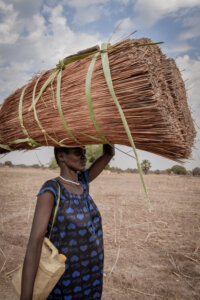
***
Another example of a humanitarian problem protracted by global warming in South Sudan is the issue of child marriage. The killings, cattle raids and even rape associated with contested resources is usually carefully documented by human rights groups, whereas child marriage is a touchier subject, as it sometimes blurs the line with Indigenous tradition. But it is a problem Elizabeth Aguil Tong, a Future Africa Leaders Award Winner 2022, has in her crosshairs, and a problem she links to environmental degradation.
Take Adut Berer, for example. Since her 16th birthday last November, she’s been a wife of three years. When 12 of her family’s cows perished during the 2020 drought, Adut was married off to a 46-year-old man. In return, her father was paid exactly 12 cows as a bride price. “It is very hard,” Adut said. “That’s all there is to say.”
Because many South Sudanese outside Juba lead pastoral lives reliant on their crops and cattle, their livelihoods are at the mercy of the elements. So when climate shocks, like a long drought or major flood, ruins their sorghum harvest or kills their cows, the country’s rural population suddenly tows a delicate line that teeters on the edge of starvation. Cattle, as Dr. Benson notes, are a significant component of bride wealth in a country where almost 73 percent of the population will face extreme poverty this year, the World Bank foreshadows.
“Families unable to make ends meet are forced into looking at their girls as a source of income,” Tong said. The young activist—with American Ivy League prospects on the horizon this fall—has repeatedly advocated the end of child marriage on Eye Radio, one of South Sudan’s most popular radio stations. But Tong understands it may not be that simple, especially considering that the issue itself is interlinked with climate.
Still, she opposes this practice not only because it “robs children of their childhood,” but because “it steals girls’ opportunity for education, which increases the number of unemployed, uneducated and underpowered women in South Sudanese society.” Creating a climate resilient future, Tong argues, is a mere pipedream if women remain subservient.
***
Too often in Western media Africa is portrayed as a caricature of itself, characterized by war, famine, disease and poverty. It’s an old trope; white person goes to Africa to tell you how terrible it’s going there. And who’s kidding who? There are plenty of places on the vast African continent where conditions are terrible. But seldom mentioned are the continent’s many internet-wired coffee shops, chic bars, swanky hotels, bustling universities, huge cosmopolitan cities, booming businesses, determined organizations, fierce activists. And South Sudan is no exception. For all its unsightly baggage, South Sudan’s saving grace is that it has people committed to seeing it improve.
Peering into South Sudan, outsiders get a glimpse of a bleak reality in store for the rest of the world. Climate change is adding fuel to the fire, helping armed conflict proliferate, worsening the spread of disease, and pushing people further below the poverty line.
Or perhaps, if one leans in for a closer look—past the bloated, abhorrently corrupt bureaucracy in Juba and beyond the gun-wielding adolescents in the bush—one will see people like Salva and Elizabeth, people trying to create climate-resilient infrastructure, improve water management systems, and establish widespread sustainable agriculture practices. People investing in renewable resources, like agroforestry and conservation agriculture. And people empowering local communities, especially women, to weather the both literal and figurative storm.
The biggest and often overlooked strategy to stifle South Sudanese conflicts, including those related to water accessibility, is to consider how to collaborate with the country’s civic-minded groups and individuals, Dr. Benson argues. South Sudanese communities, he added, have long standing and intimate understandings of the natural world and know how climate change will impact livelihoods for the worse.
“Like any other part of the world, most South Sudanese people I collaborate with and conduct research among, have strikingly clear ideas of how the country ought to be run in ways that benefit most people rather than a select few,” he said.
Ahead lies an uncertain future. Not only for South Sudan, but the whole world as the spectre of climate change looms. But the problem is a man-made one, Salva Dut says, and so the solutions must be, too.
All photos by the author, Ryan Biller. This story was fact checked by Julie Collazzo.
Before you go, we hope you’ll consider supporting DAME’s journalism.
Today, just tiny number of corporations and billionaire owners are in control the news we watch and read. That influence shapes our culture and our understanding of the world. But at DAME, we serve as a counterbalance by doing things differently. We’re reader funded, which means our only agenda is to serve our readers. No both sides, no false equivalencies, no billionaire interests. Just our mission to publish the information and reporting that help you navigate the most complex issues we face.
But to keep publishing, stay independent and paywall free for all, we urgently need more support. During our Spring Membership drive, we hope you’ll join the community helping to build a more equitable media landscape with a monthly membership of just $5.00 per month or one-time gift in any amount.

















































































